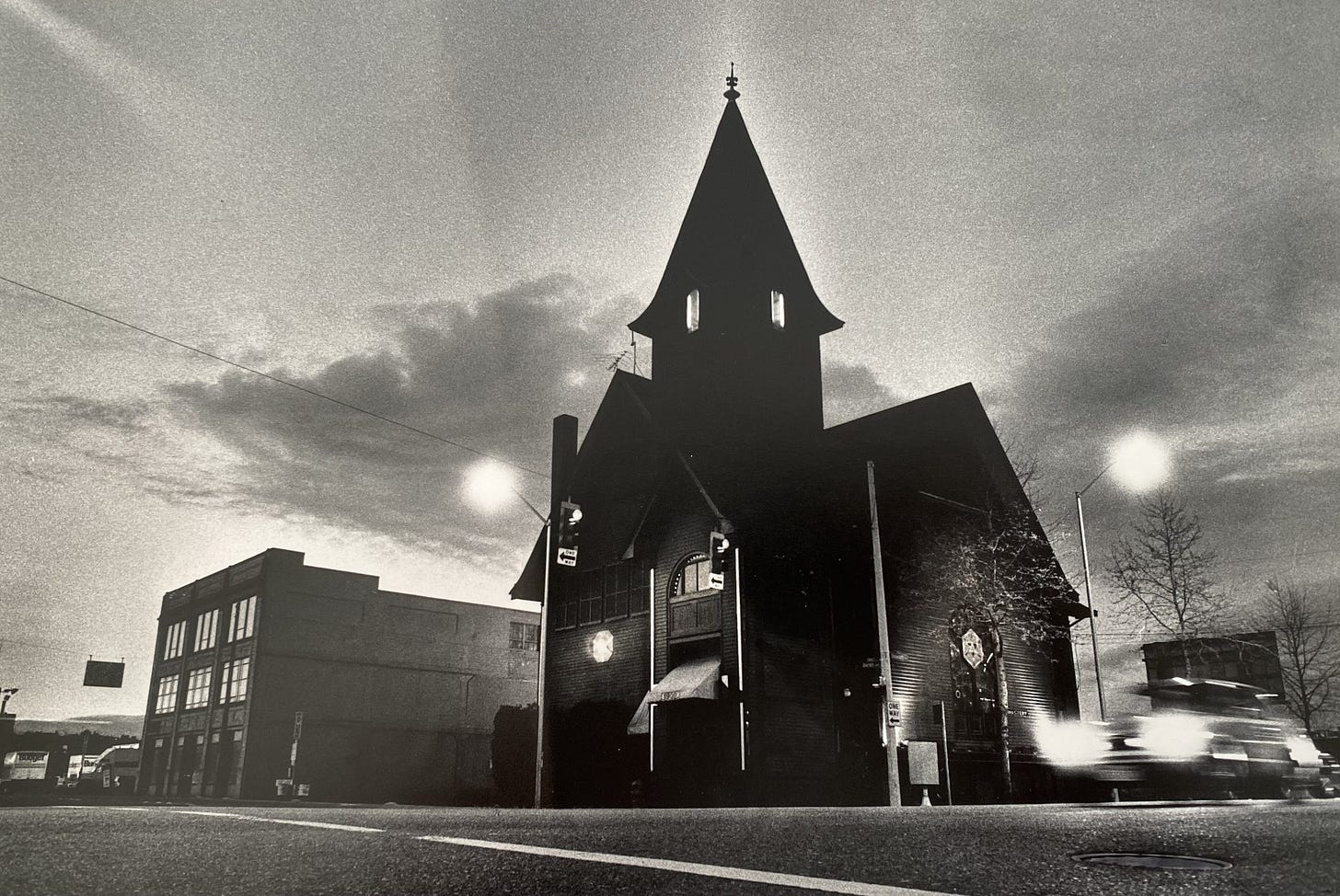A recent stroll through a flea market led to the discovery of a black & white photo of The Monastery - that infamous church-turned-nightclub which operated in Seattle during the ‘80s. The photograph looked like it was taken at dusk with the silhouette of the club’s steeple in stark contrast to the early evening sky, giving it an appropriate gothic effect. The vendor was only asking a few dollars, making it an easy purchase; especially considering its high nostalgic value as the club had been the source of constant lore during my teen years.
Somewhat regretfully, I never had the opportunity to visit The Monastery. It closed down a few years before my friends or I would have been old enough to visit such places. The enduring stories about it were legendary though. An upstairs theater space played cult movies like The Hunger (vampire flick starring David Bowie) on repeat. The drugs were said to be plentiful and came in all varieties, with MDMA reportedly handed out like candy and an orange juice machine available to help boost the effects of any psychedelics. There were also tales of wild sexual escapades involving a private hot tub, as well as a rumored orgy room. For several years, the club served as the epicenter of all things hedonistic and debaucherous in the local area.
Located at the northeast corner of Stewart and Boren, The Monastery originally started out as a turn-of-the-century Methodist church with a steeply pitched roof, stained glass windows, and a towering steeple. As the story goes, a nightclub owner by the name of George Freeman moved here from New York City in 1977, and one of the first things he noticed was the absence of a vibrant nightlife. Seeking to change that, he traveled around the city looking for the perfect location to open a late-night dance club. He soon found himself in front of the rundown church with a “For Rent” sign in front and the rest, as they say, is history.
George worked quickly to transform the space into an after-hours private club, bringing in a few of his associates to help introduce New York-style clubbing to Seattle. On Friday the 13th, in May 1977, The Monastery held its grand opening in extravagant fashion. With lines stretching around the block, and four big searchlights illuminating the steeple, George and one of his DJ friends landed across the street in a helicopter, emerging in monk’s robes. And so began the story of The Monastery. An article I found online best describes what the scene inside was like:
“The pulpit at the Monastery was the DJ booth, designed with a booming sound system and wild disco lights. The members of the congregation -- kids and adults, white and black, gay and straight -- were left to worship in any way they wished: dancing, declaring brotherly love in private hot-tub baptismal fonts, slipping upstairs to drink from holy sacrament kegs in the loft. At 2:00 a.m., Reverend George would deliver his sermon.”
Indeed, from its earliest days, The Monastery welcomed people from all walks of life, with the crowd always a balanced mix of Seattle culture. The wild and over-the-top festivities would often go late into the night and into the next morning, with Freeman providing a huge breakfast for any remaining club-goers.
However, this was during the days of the teen runaway epidemic, as captured in the famous documentary “Streetwise,” and The Monastery became a part of that story, quickly garnering a reputation as being a place where street kids were exposed to the more unsavory elements of Seattle nightlife. Whether well-founded or not, the level of decadence found at the Monastery made it into a convenient scapegoat for Seattle’s teen runaway problem, becoming one of the primary sources of blame for leading local kids astray. As a result, The Monastery became embroiled in controversy.
It wasn’t long before The Monastery found itself under constant attack from various Seattle officials who accused the nightclub of corrupting local youth. As early as October 1977, the Seattle Police Department began raiding the club on a regular basis, charging Freeman with “blatant drug trafficking, liquor-code violations, and licentious conduct involving under-age clients.” In one of the larger police raids, over 200 people were arrested there on a single night. This led to a back-and-forth volley of charges, arrests, and appeals over the years and in 1984, King County Prosecutor Norm Maleng filed a civil abatement action against the Monastery, alleging drug use, prostitution, and underage drinking as reasons for shutting it down. He was successful in his efforts and months later the club was permanently closed and subsequently demolished. Around the same time, Seattle passed the controversial Teen Dance Ordinance which restricted underage minors from attending such venues and to deter copycats from ever sprouting up again. In the end, The Monastery somehow managed to stay open for eight long years before meeting its inevitable demise.
As far as George Freeman, he remains living in Seattle. Despite being an octogenarian, he is still very much an extravagant personality as is evident by his over-the-top Capitol Hill house that can be seen from I-5, right before the 520 interchange. It’s the eye-catching one with a glass window exterior lit up by bright purple and blue lights, and which almost resembles a nightclub. In fact, in true George Freeman fashion, he hosts frequent parties there and has nicknamed his home “The Rectory.”





The movies were downstairs. I have vivid memories of seeing Videodrome and Re-Animator
while really high 🫣😵💫
Great piece. As a follow up, any chance of scoring a George Freeman interview?